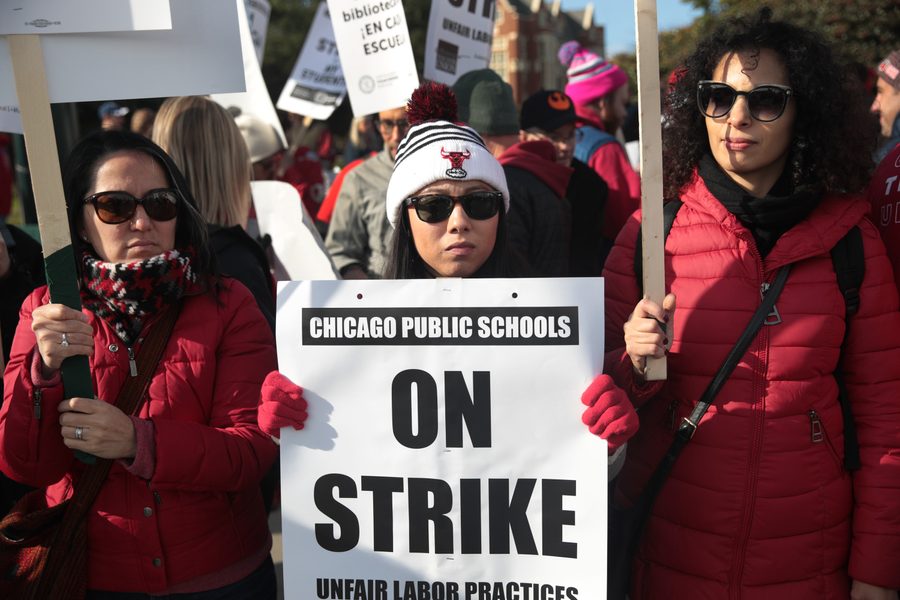Why Are Chicago Teachers Striking Against Mayor Lori Lightfoot? They’ve Been “Lied To” Before.
Kari Lydersen

As a pink sunrise painted the sky on Thursday morning, horns blared seemingly nonstop from semi trucks, commuters’ cars, a concrete mixer and countless other vehicles. They were all supporting members of the Chicago Teachers Union (CTU) and SEIU Local 73, which represents school support staff, on the picket line before dawn outside John A. Walsh Elementary School in Chicago’s heavily immigrant Pilsen neighborhood.
At schools across the city, teachers and staff waved signs, blew whistles, chanted and cheered to a cacophony of supportive honking from morning traffic. Teachers said they’re disappointed that the administration of Mayor Lori Lightfoot has not yet followed through on campaign promises to increase school staffing, shrink class sizes, create an elected school board and otherwise bolster public education. But with the support of the public — and a whopping 94% of membership voting to strike — they are hopeful.
“People in the schools every day can’t bear to see what’s happening,” said Walsh counselor Kristy Brooks. “Kids in Chicago have tough lives, they’re dealing with poverty, immigration fears, violence, and we’re asking them to put all that aside when they come here. That’s a lot to ask. That’s why we need these support systems.”
Brooks, who has been in the school system for 14 years, previously worked at a school on the West Side that was closed during former Mayor Rahm Emanuel’s shuttering of almost 50 schools. She said students, families and teachers still haven’t recovered from the impacts of those school closings, not to mention the gentrification, violence and other trauma that causes students to need far more access to counselors, nurses and social workers than is currently available. Most schools have a nurse on site only once a week, and CPS’s ratios of students to nurses and social workers are about four and five times higher than recommended by those professions’ national associations, according to the union.
Earlier this summer, Lightfoot announced the hiring of hundreds of nurses and social workers, and said in a statement last week that her administration is committing $400,000 to “developing a pipeline of nurses, counselors and case managers.” But the union wants specific benchmarks written into their contract — a demand the administration has resisted.
On Thursday morning, counselor Mary Jane Nykiel picketed outside Richard T. Crane Medical Prep High School on the Near West Side, a neighborhood with a large African-American population.
“Because of the lack of other clinicians, counselors are spread very thin and asked to do other duties that aren’t counselor duties,” Nykiel said. “We’re pulled in many directions.”
She said that the school, which was considered for closure by Emanuel’s administration, “has a beautiful library but hasn’t had a librarian in 15 years.” Nykiel serves 450 students, and the school has a nurse twice a week and a social worker once a week, she said, which isn’t near enough “especially on the West Side where there’s so much inequity and poverty and trauma.”
Nykiel noted that even after the teachers garnered important contract gains and massive public support during the 2012 strike, the administration still carried out among the largest mass school closings in U.S. history soon after.
To Daniel Washco, a ninth-grade English teacher at Richard T. Crane Medical Prep High School on the city’s West Side, those closings underscored that promises from the administration — like Lightfoot’s pledges to hire more nurses and social workers — are not enough. “Now put it in writing,” he said.
Washco was excited and hopeful when Lightfoot was elected, and still feels “her heart is in the right place.” The outcome of the strike will be telling, he said: “This is where the rubber meets the road.”
At Walsh, Brooks serves 302 students, a smaller number than counselors at many schools, though still above the American School Counselor Association’s recommended level of 250 students per counselor. And her relatively light load is in part because of gentrification in the neighborhood. The school has lost about 50% of its student body in the six years Brooks has been there, she said, with immigrant families displaced as the neighborhood becomes more expensive. Across the street from the school, newly built, still-unoccupied condos cover an entire city block.
The impacts of gentrification and lack of affordable housing on students, teachers and especially school paraprofessionals like clerks are among the reasons CTU has demanded the administration agree to endorse rent control and specific affordable housing provisions. Nearly a quarter of paraprofessionals make less than $32,000 a year, according to the union. One picket sign said, “My bar job paid for this sign.”
“It’s incredibly difficult for parents and teachers to be able to live near their schools and be part of their community” because of rising housing prices, said Washco.
In a statement, Lightfoot said CTU wanted to “set the city’s affordable housing policy through their collective bargaining agreement,” which would sideline other stakeholders. She said she “appointed the city’s first housing commissioner in a decade,” while also announcing a plan for low-income housing tax credits.
Esther Valenciano raised her kids in Pilsen and they graduated from Walsh, just around the corner from their home. Valenciano has worked at Walsh as a preschool teaching assistant for 23 years, but when she decided to buy a home, she couldn’t afford to stay in Pilsen. Now her son and daughter also work in Chicago Public Schools (CPS) as teaching assistants, and are studying to become teachers.
Valenciano and the teacher she assists are often in charge of more than 40 preschoolers, including some with special needs. “They’re little kids, so we have to be fast,” she said. “Especially in gym, it becomes a safety issue. It should not be that way.”
Valenciano finds herself, teachers, parents and grandparents all working together “as our own social workers” to try to help kids with problems when no case managers are available. “We do what we can do together,” she said.
Meanwhile, counselors say they’re often doing the jobs of social workers, plus helping in the classroom, lunchroom or recess, along with their primary responsibility of advising students about academics, college and careers.
Outside Nixon Elementary on the city’s largely Hispanic, working-class Northwest Side, librarian and union delegate Leslie Westerberg picketed with her shelter rescue dog, Milo, wearing a homemade union dog jacket. A CPS school Westerberg previously worked at closed its library and dismantled the bookshelves to turn it into a classroom, she said. She doesn’t know what happened to all the books she fundraised to buy.
At Nixon, Westerberg said she’s lucky to have a principal who prioritizes the library, but she notes many schools can’t do that as the system’s student-based budgeting formula means principals have to make tough choices when allocating scarce resources.
“We want students to know how to research and be ready for college, and we want them to excel at reading and have a love of reading, but how can we do that without libraries and librarians?” she asked. She said the union understands that higher staffing levels of librarians, counselors, social workers and nurses may need to be phased in over time, but she still wants the positions mandated in the contract and funded through the central office so that candidates can be hired when they are found.
“It’s unfair to our students that we have to beg for this,” she said. “It’s concerning that [Lightfoot] is offering things but not putting them in writing, so we could potentially be lied to, and CPS has lied to us so many times. They still need to earn our trust.”
Across the street from Westerberg, fifth-grade math teacher Samantha Gill and special education assistant Diana Morales wore unicorn and tiger onesies as they danced Zumba and Gill waved a glittery microphone.
“City officials don’t understand the relationships we have with kids, that we are literally doing all of this for them,” said Morales, an SEIU Local 73 member. “It’s not fair to kids not to have nurses, librarians, counselors. We owe them the best, and this isn’t the best.”
Gill said kindergarteners have told her that it’s hard for them to be successful with more than 40 kids in a class. “The kids understand it,” she said. “Why can’t the politicians understand it?”

I hope you found this article important. Before you leave, I want to ask you to consider supporting our work with a donation. In These Times needs readers like you to help sustain our mission. We don’t depend on—or want—corporate advertising or deep-pocketed billionaires to fund our journalism. We’re supported by you, the reader, so we can focus on covering the issues that matter most to the progressive movement without fear or compromise.
Our work isn’t hidden behind a paywall because of people like you who support our journalism. We want to keep it that way. If you value the work we do and the movements we cover, please consider donating to In These Times.
Kari Lydersen is a Chicago-based journalist, author and assistant professor at Northwestern University, where she leads the investigative specialization at the Medill School of Journalism, Media, Integrated Marketing Communications. Her books include Mayor 1%: Rahm Emanuel and the Rise of Chicago’s 99%.







